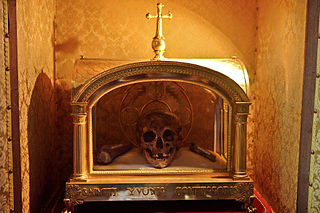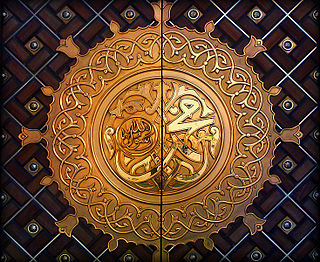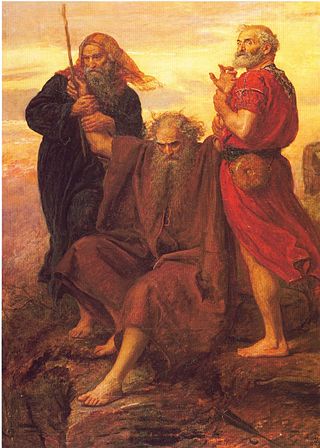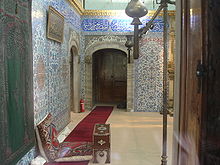
Uthman ibn Affan was the third caliph, ruling from 644 until his assassination in 656. Uthman, a second cousin, son-in-law, and notable companion of the Islamic prophet Muhammad, played a major role in early Islamic history. During his reign as caliph, he was known for ordering the official compilation of the standardized version of the Quran that is still being used today.

In religion, a relic is an object or article of religious significance from the past. It usually consists of the physical remains or personal effects of a saint or other person preserved for the purpose of veneration as a tangible memorial. Relics are an important aspect of some forms of Buddhism, Christianity, Islam, shamanism, and many other religions. Relic derives from the Latin reliquiae, meaning "remains", and a form of the Latin verb relinquere, to "leave behind, or abandon". A reliquary is a shrine that houses one or more religious relics.

The Black Stone is a rock set into the eastern corner of the Kaaba, the ancient building in the center of the Grand Mosque in Mecca, Saudi Arabia. It is revered by Muslims as an Islamic relic which, according to Muslim tradition, dates back to the time of Adam and Eve.

The Prophet's Mosque is the second mosque built by the Islamic prophet Muhammad in Medina, after that of Quba, as well as the second largest mosque and holiest site in Islam, after the Masjid al-Haram in Mecca, in the Saudi region of the Hejaz. The mosque is located at the heart of Medina, and is a major site of pilgrimage that falls under the purview of the Custodian of the Two Holy Mosques.

Ibn Qudāmah al-Maqdisī Muwaffaq ad-Dīn Abū Muḥammad ʿAbd Allāh ibn Aḥmad ibn Muḥammad , better known as Ibn Qudāmah, was a Sunni Muslim scholar, jurist, theologian, traditionist, and ascetic. Having authored many important treatises on Islamic jurisprudence and religious doctrine, including one of the standard works of Hanbali law, the revered al-Mughni, Ibn Qudamah is highly regarded in Sunni Islam for being one of the most notable and influential thinkers of the Hanbali school of orthodox Sunni jurisprudence. Within that school, he is one of the few thinkers to be given the honorific epithet of Shaykh of Islam, which is a prestigious title bestowed by Sunnis on some of the most important thinkers of their tradition. A proponent of the classical Sunni position of the "differences between the scholars being a mercy," Ibn Qudamah is famous for saying, "The consensus of the leaders of jurisprudence is an overwhelming proof, and their disagreement is a vast mercy."
Al-Muqawqis is mentioned in Muslim history as a ruler of Egypt who corresponded with Muhammad. He is widely identified with the last prefect of Egypt, Cyrus of Alexandria, who was the Greek Orthodox Patriarch of Alexandria of the second era of Byzantine Egypt (628-642).

Siyer-i Nebi is an Ottoman epic on the life of the Islamic prophet Muhammad, completed around 1388, written by Mustafa, a Mevlevi dervish on the commission of Sultan Barquq, the Mamluk ruler in Cairo. The text is based on the 13th-century writings of Abu’l Hasan al-Bakri and Ibn Hisham. This epic would later be illustrated by Mustafa ibn Vali in the late 16th century, as commissioned by his patron, Sultan Murad III.
Zāyd bin Thābit bin al-Ḍaḥḥāk was the personal scribe of the Islamic prophet Muhammad, serving as the chief recorder of the Quranic text. He hailed from the ansar (helpers), later joined the ranks of the Muslim army at age 19. After Muhammad's passing in 632, he was ordered to collect the Quran into a single volume from various written and oral sources. He was a noted expert on the Quran and spent much time reciting it.

The Samarkand Kufic Quran is an 8th or 9th century manuscript Quran written in the territory of modern Iraq in the Kufic script, where it was later taken by Tamerlane to Samarkand. Today it is kept in the Hast Imam library, in Tashkent, Uzbekistan.

The Islamic Sacred Relics, also known as the Holy Relics, known collectively as the Sacred Trust, consist of religious relics sent to the Ottoman Sultans between the 16th century to the late 19th century.

The Topkapi manuscript or Topkapi Quran is an early manuscript of the Quran dated to the early 2nd century AH.

Muḥammad ibn ʿAbd Allāh ibn ʿAbd al-Muṭṭalib is believed to be the Seal of the Prophets in all of the main branches of Islam. Muslims believe that the Quran, the central religious text of Islam, was revealed to Muhammad by God, and that Muhammad was sent to restore Islam, which they believe did not originate with Muhammad but is the true unaltered original monotheistic faith of Adam, Abraham, Moses, Jesus, and other prophets. The religious, social, and political tenets that Muhammad established with the Quran became the foundation of Islam and the Muslim world.

Turkish art refers to all works of visual art originating from the geographical area of what is present day Turkey since the arrival of the Turks in the Middle Ages. Turkey also was the home of much significant art produced by earlier cultures, including the Hittites, Ancient Greeks, and Byzantines. Ottoman art is therefore the dominant element of Turkish art before the 20th century, although the Seljuks and other earlier Turks also contributed. The 16th and 17th centuries are generally recognized as the finest period for art in the Ottoman Empire, much of it associated with the huge Imperial court. In particular the long reign of Suleiman the Magnificent from 1520 to 1566 brought a combination, rare in any ruling dynasty, of political and military success with strong encouragement of the arts.

The Staff of Moses, also known as the Rod of Moses or Staff of God, is mentioned in the Bible and Quran as a walking stick used by Moses. According to the Book of Exodus, the staff was used to produce water from a rock, was transformed into a snake and back, and was used at the parting of the Red Sea. Whether the staff of Moses was the same as the staff used by his brother Aaron has been debated by rabbinical scholars.

The Seal of Muhammad is one of the relics of Muhammad kept in the Topkapı Palace by the Ottoman Sultans as part of the Sacred Relics collection.
The possessions of the Islamic prophet Muhammad are a group of his items and possessions such as weapons, armor and clothing, including those known with unique names. There is doubt about the attribution of these possessions to Muhammad, as many of them were lost during wars and tribulations.

Hırka-i Şerif Mosque is a historic mosque in Istanbul, Turkey. It takes its name from a relic, the mantle of Muhammad, which is preserved in the mosque.

Muhammad ibn al-Katib Sinan al-Qunawi, also known as Muhammad ibn Yusuf, was an Ottoman astronomer and muwaqqit (timekeeper) in the late fifteenth and early sixteenth century. A pioneer of Ottoman astronomy, especially in the field of astronomical instruments and timekeeping, he served as muwaqqit at various mosques, and eventually at the Sublime Porte under Suleiman the Magnificent. He was influenced by earlier Mamluk astronomers, especially Shams al-Din al-Khalili (1320–1380) and Ibn al-Shatir, as well as by the Central Asian Ali al-Qushji and Al-Biruni.
The Sancak-ı Şerif is the alleged original standard of the Islamic prophet Muhammad. It is kept along with other relics of Muhammad, in the treasury of the Topkapı Palace, in Istanbul.


















